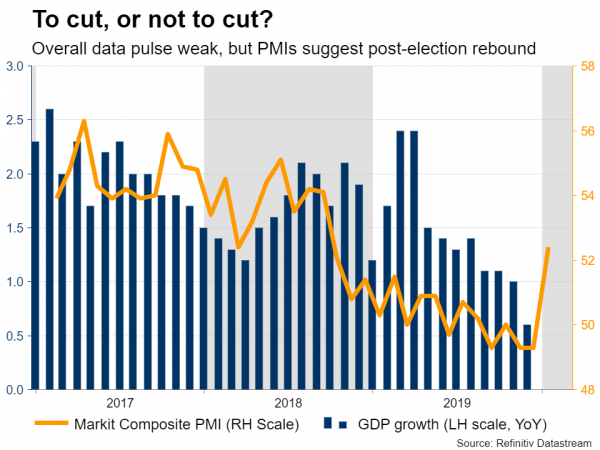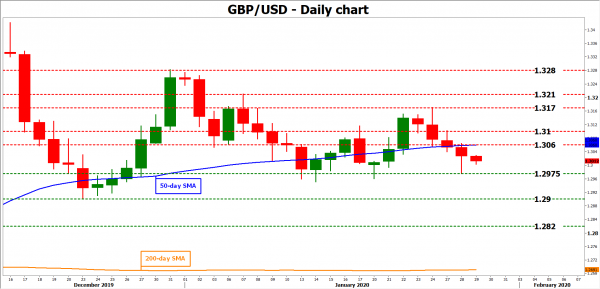The Bank of England (BoE) is having its first policy meeting for 2020 on Thursday at 12:00 GMT and a day before the UK officially departs from the EU. Despite the political relief, the rate decision, which will be the last for Governor Mark Carney before his term ends in mid-March, may not be an easy task. Nevertheless, expectations are for the Bank to keep rates at the same level and remain patient until further notice.
BoE may pause for thought
A group of dovish policymakers including BoE chief Mark Carney recently indicated that a rate cut may be on the cards at the beginning of this year if the economy continues to slow down, raising the odds for such an outcome in January to roughly 50%, according to overnight index swaps.
Indeed, GDP growth shrank by 0.3% month-on-month in November while the three-month average tumbled to 0.6% year-on-year from 1.0% in the preceding month. Inflation was a weak spot as well, as the headline Consumer Price Index further eased to 1.3% in December, remaining well below the central bank’s 2.0% target.
Taking the above data into account, the monetary decision should reasonably lean towards a rate reduction. But this could be a biased decision as the numbers are outdated and regard a period when political uncertainty about Boris Johnson’s withdrawal agreement was still high.
Following the UK elections in mid-December which gave the green light to the UK prime minister to pass his Brexit deal through the Parliament, policymakers are eagerly waiting to see how political relief will improve consumption and business sentiment in the new year.

So far, January’s Markit PMI survey released last week and the upbeat CBI quarterly industrial survey are the only important pieces of evidence that reflect the post-election period, and both suggest the economy improved substantially. The services sector – which accounts for the vast majority of the British economy – returned to expansion, with the corresponding PMI reading rising back above the 50 threshold. The manufacturing industry, despite remaining in contraction, also rebounded from previous lows, while the CBI report revealed that business optimism rose to the highest since 2014.
With employment growth surging by more than 200k in November and wage growth holding the highest since the financial crisis, the Committee members may pause for thought on Thursday, likely leaving interest rates steady for now and adopting a wait-and-see approach until further notice.
Rate cut could be a close call though
The problem that arises here is that if the central bank keeps borrowing costs the same and the upcoming data disappoint then the BoE could only act at the next policy meeting in late-March and under the new chief Andrew Bailey. Such a delay could be risky, allowing the economy to further lose steam. Having said that, even though a rate cut could be a close call this Thursday, the Bank might find it difficult to justify a rate cut for now without any recent data, with expectations being for the BoE to do nothing on Thursday.
GBPUSD levels to watch
As regards the pound, since markets are not certain whether a rate cut will happen or not, the currency could experience an upside move if the central bank keeps monetary policy the same. How far the currency could rally though may depend on the language used in the monetary statement and Carney’s tone at his press conference speech.

If the central bank remains cautious about the future of the UK economy and the EU-UK trade negotiations, which Boris Johnson wants to successfully finalize before the year-end without extending the transition period, then the upside reaction may not be significant. Nevertheless, GBPUSD traders could initially look for resistance near 1.3060 and then around 1.3100.
In the negative scenario where all five of the dovish policymakers vote for a rate reduction instead of the three that economists expect, the pound would shift south to retest the key 1.2975 support area, which if violated would open the way towards the 1.2900 barrier.


 Signal2forex.com - Best Forex robots and signals
Signal2forex.com - Best Forex robots and signals




